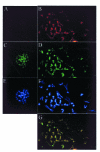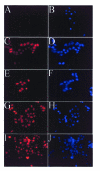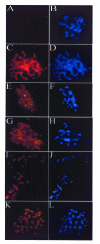The DNA segregation mechanism of Epstein-Barr virus nuclear antigen 1
- PMID: 11265753
- PMCID: PMC1084258
- DOI: 10.1093/embo-reports/kvd026
The DNA segregation mechanism of Epstein-Barr virus nuclear antigen 1
Abstract
Latent Epstein-Barr virus (EBV) genomes are maintained in human cells as low copy number episomes that are thought to be partitioned by attachment to the cellular mitotic chromosomes through the viral EBNA1 protein. We have identified a human protein, EBP2, which interacts with the EBNA1 sequences that govern EBV partitioning. Here we show that, in mitosis, EBP2 localizes to the condensed cellular chromosomes producing a staining pattern that is indistinguishable from that of EBNA1. The localization of EBNA1 proteins with mutations in the EBP2 binding region was also examined. An EBNA1 mutant (delta325-376) disrupted for EBP2 binding and segregation function was nuclear but failed to attach to the cellular chromosomes in mitosis. Our results indicate that amino acids 325-376 mediate the binding of EBNA1 to mitotic chromosomes and strongly suggest that EBNA1 mediates EBV segregation by attaching to EBP2 on the cellular mitotic chromosomes.
Figures




References
-
- Chatterjee A., Freeman, J.W. and Busch, H. (1987) Identification and partial characterization of a Mr 40,000 nucleolar antigen associated with cell proliferation. Cancer Res., 47, 1123–1129. - PubMed
-
- Fischer N., Kremmer, E., Lautscham, G., Mueller-Lantzsch, N. and Grasser, F.A. (1997) Epstein–Barr virus nuclear antigen 1 forms a complex with the nuclear transporter karyopherin α2. J. Biol. Chem., 272, 3999–4005. - PubMed
Publication types
MeSH terms
Substances
LinkOut - more resources
Full Text Sources

